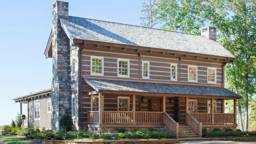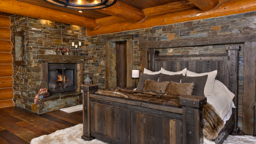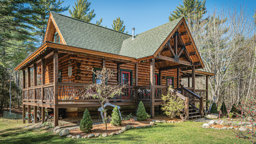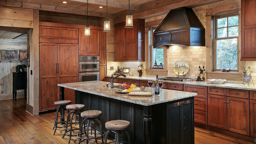Basic Log Home Questions: All About Logs
Here are a series of thought-provoking questions to help prepare you for the task of building a new log home.
5 More Questions to Begin the Log Home Building Process
Thought-provoking questions to help prepare you for the task of building a new log home.
6. What profile will your logs have?
To appeal to a variety of customers, most log home producers offer quite an array of log profiles. It's obviously a big decision affecting the final appearance of your log home. Structural differences between the different types of log profiles are relatively insignificant. What you do want to know before deciding on a log profile is exactly how the logs will look once they are stacked, the height and width of the logs, how butt joints (vertical joints formed where the ends of the logs meet) will look and how the horizontal joints formed where the top and bottom of logs meet will look. Again the main consideration is that log profile can also dictate the . Trust your own preferences when making this decision, or use the log profile recommended by your producer.
7. Will the logs be precut?
Log packages that are entirely precut can be put together without using a saw or drill. Logs that are not precut will have to be cut to the correct length and notched onsite before they can be placed into the wall. The matter isn't a question of which system is best; it's truly a question of time and cost. Log packages generally are sold as totally precut, partially precut or random-length packages. You should know which cuts will be made and which holes will be drilled on the job site. Will your logs be cut to length and completely notched? Can the corners be assembled without further cutting or notching? Are the logs used at gable ends completely precut, or will they need to be cut to the proper angle? Will holes for fasteners or electrical wiring be predrilled? Again, if you have not already chosen a log home producer, the level of pre-cutting may be very important, especially if you plan to complete some of the construction work yourself.
8. What level of moisture content will the logs have?
The benefits of building with green logs (those with a high moisture content) or logs dried naturally (such as standing- dead logs) or mechanically (kiln-dried logs) are often debated. The fact is that thousands of log homes have been successfully built using either green logs or dried logs. There really is no industry consensus on which is better. Regardless, to ease any confusion you may have on this issue, consider these questions: Do you understand the effects of a log's moisture content on the method used to construct a log home? Do you believe the producer you have chosen understands the issue and has compensated for the moisture content of the logs in the construction system or materials that will be used?
9. Will your logs be treated?
Many logs are treated with a preservative at the producers' plants. This preservative helps protect logs from discoloration during shipping and erection, and is generally only necessary in warm weather months and in regions that have high humidity. Other log home producers may apply a long-term, even permanent, preservative treatment. It's important for you to know what preservatives have already been used on your logs, because it will affect both your selection of stains and caulks and your required maintenance tasks in the future. Ask your producer if your logs will be treated with a preservative treatment intended to prevent deterioration by insects, molds, mildew and fungus attacks, and, if so, how long you can expect this protection to last.
10. What building system will be used on your home?
Much of this buyer's guide and many company brochures and catalogs focus on the technical aspects of log building. Though you may feel that you have to master these topics in order to find the perfect log home, remember that while none of these issues is trivial, they should not overwhelm you to the point of indecision or intimidation. No one building system, wood species or sealing system is so far superior to any other as to make the others unacceptable.
Hundreds of companies produce new log homes every year, and few if any use the same combination of methods and materials. Most producers have used their building systems to build hundreds, even thousands, of homes successfully. In order to more fully understand a producer's building system, you may want to review these points: how the system complies with building codes; what fasteners and sealants are used; how the system accommodates settling; and whether the logs are graded. Producers' sales representatives may focus their pitches on other technical issues as well. While you should carefully consider these issues, try to balance the technical aspects with other equally important issues that affect home buying decisions.





_11868_2023-12-20_08-12-256x288.jpg)





